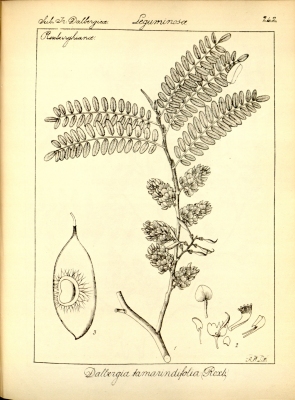Dalbergia pinnata
(Lour.) Prain
Fabaceae
Dalbergia tamarindifolia Roxb.
Derris pinnata Lour.
Common Name:
General Information
Dalbergia pinnata is a deciduous climbing shrub or small tree growing up to 12 metres tall.
The plant is harvested from the wild for local medicinal use[
]. It is also cultivated in home gardens in Java as a medicinal plant[
].
Known Hazards
None known
Botanical References
266- Title
- Flora of China
- Publication
-
- Author
-
- Website
- http://flora.huh.harvard.edu/china/
- Publisher
- Missouri Botanical Garden Press; St. Louis.
- Year
- 1994
- ISBN
-
- Description
- An excellent, comprehensive resource in 25 volumes. In addition to the botanical information the flora also gives basic information on habitat and some uses. An on-line version is also available.
,
1792- Title
- An account of Dalbergia (Leguminosae-Papilionoideae) in Thailand
- Publication
- Thai For. Bull. (Bot.) 30 124-166 2002
- Author
- Chawalit Niyomdham
- Publisher
-
- Year
- 2002
- ISBN
-
- Description
-
Range
E. Asia - southern China, Vietnam, Laos, Thailand, Myanmar, Malaysia, Indonesia, Philippines.
Habitat
Dense forests at elevations below 1,400 metres in southern China[
266- Title
- Flora of China
- Publication
-
- Author
-
- Website
- http://flora.huh.harvard.edu/china/
- Publisher
- Missouri Botanical Garden Press; St. Louis.
- Year
- 1994
- ISBN
-
- Description
- An excellent, comprehensive resource in 25 volumes. In addition to the botanical information the flora also gives basic information on habitat and some uses. An on-line version is also available.
].
Properties
| Medicinal Rating |      |
| Habit | Tree |
| Height | 8.00 m |
| Cultivation Status | Cultivated, Wild |
Cultivation Details
Species in this genus are mainly found in the wild growing in sany soils and on limestone escarpments[
200- Title
- The New RHS Dictionary of Gardening. 1992.
- Publication
-
- Author
- Huxley. A.
- Publisher
- MacMillan Press
- Year
- 1992
- ISBN
- 0-333-47494-5
- Description
- Excellent and very comprehensive, though it contains a number of silly mistakes. Readable yet also very detailed.
]. In cultivation they are likely to do well in a fertile, loam soil and a position in full sun[
200- Title
- The New RHS Dictionary of Gardening. 1992.
- Publication
-
- Author
- Huxley. A.
- Publisher
- MacMillan Press
- Year
- 1992
- ISBN
- 0-333-47494-5
- Description
- Excellent and very comprehensive, though it contains a number of silly mistakes. Readable yet also very detailed.
].
This species has a symbiotic relationship with certain soil bacteria, these bacteria form nodules on the roots and fix atmospheric nitrogen. Some of this nitrogen is utilized by the growing plant but some can also be used by other plants growing nearby[
755- Title
- Nodulation Plants in GRIN Taxonomy
- Publication
-
- Author
-
- Website
- http://www.ars-grin.gov/~sbmljw/cgi-bin/taxnodul.pl?language=en
- Publisher
- United States Department of Agriculture
- Year
- 0
- ISBN
-
- Description
- An online database listing plants that have either positive or negative reports on root and stem nodulation with nitrogen-fixing bacteria.
].
Edible Uses
The root is used as a masticatory[
240- Title
- Glossary of Indian Medicinal Plants (Including the Supplement).
- Publication
-
- Author
- Chopra. R. N., Nayar. S. L. and Chopra. I. C.
- Publisher
- Council of Scientific and Industrial Research, New Delhi.
- Year
- 1986
- ISBN
- -
- Description
- Very terse details of medicinal uses of plants with a wide range of references and details of research into the plants chemistry. Not for the casual reader.
].
Medicinal
The bark and roots are used medicinally[
].
The root is used as an anthelmintic[
240- Title
- Glossary of Indian Medicinal Plants (Including the Supplement).
- Publication
-
- Author
- Chopra. R. N., Nayar. S. L. and Chopra. I. C.
- Publisher
- Council of Scientific and Industrial Research, New Delhi.
- Year
- 1986
- ISBN
- -
- Description
- Very terse details of medicinal uses of plants with a wide range of references and details of research into the plants chemistry. Not for the casual reader.
].
Other Uses
None known
Propagation
Like many species within the family Fabaceae, once they have been dried for storage the seeds of this species may benefit from scarification before sowing in order to speed up germination. This can usually be done by pouring a small amount of nearly boiling water on the seeds (being careful not to cook them!) and then soaking them for 12 - 24 hours in warm water. By this time they should have imbibed moisture and swollen - if they have not, then carefully make a nick in the seedcoat (being careful not to damage the embryo) and soak for a further 12 hours before sowing[
K- Title
- Plants for a Future
- Author
- Ken Fern
- Description
- Notes from observations, tasting etc at Plants For A Future and on field trips.
].
Softwood cuttings of many species, especially if taken from younger plants, will root in a well-drained, sandy medium in a closed case with bottom heat[
200- Title
- The New RHS Dictionary of Gardening. 1992.
- Publication
-
- Author
- Huxley. A.
- Publisher
- MacMillan Press
- Year
- 1992
- ISBN
- 0-333-47494-5
- Description
- Excellent and very comprehensive, though it contains a number of silly mistakes. Readable yet also very detailed.
].
If you have any useful information about this plant, please leave a comment. Comments have to be approved before they are shown here.






 Useful Tropical Plants Database 2014 by
Ken Fern,
web interface by
Ajna Fern
with help from
Richard Morris.
Useful Tropical Plants Database 2014 by
Ken Fern,
web interface by
Ajna Fern
with help from
Richard Morris.